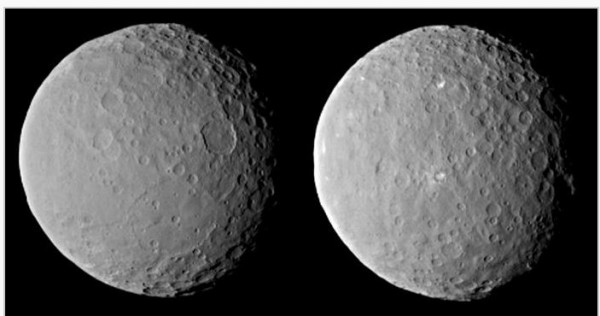Ice volcanoes on Ceres Hint at Life Beneath its Icy Surface
| Arthur Dominic Villasanta | | Mar 19, 2015 09:55 PM EDT |
Ceres from Dawn, 47,000 kilometers away, on 19 February 2015.
Those intriguing bright spots on the dwarf planet Ceres that have piqued the imagination of scientists might well turn out to be ice volcanoes or "cryovolcanoes".
Scientists believe these ice volcanoes, like their counterparts on Saturn's icy moons Enceladus and Titan, hurl water vapor into space. The Ceres cryovolcanoes raise the possibility a life-giving ocean exists beneath the surface of the dwarf planet.
Like Us on Facebook
But there's another explanation for these bright surface spots. They could be plumes caused by sun-warmed icy patches, an effect seen in the tails of comets.
Scientists will know for certain what the answer is after mid-April when NASA's Dawn spacecraft now orbiting Ceres emerges from the dark side of the dwarf planet
Ceres or 1 Ceres, its minor-planet designation, is the largest object in the asteroid belt between the orbits of Mars and Jupiter. With a diameter of 950 kilometers, Ceres consists of rock and ice and accounts for one third of the mass of the asteroid belt.
It's the only dwarf planet in the inner Solar System and the only object in the asteroid belt known to be unambiguously rounded by its own gravity. Ceres was the first asteroid to be discovered on January 1, 1801 by Giuseppe Piazzi in Palermo.
The first definitive detection of water vapor on Ceres was made in January 2014 by the Herschel space observatory. In 2005, images from the Hubble space telescope suggested the possibility of water ice.
The mysterious bright spots are inside a crater in black-and-white images received from Dawn mid-February. During one full, nine-hour rotation, Dawn showed the brighter of the two spots could be seen even from the side, indicating it extends beyond the crater's apparent boundaries.
NASA's Dawn spacecraft went into orbit around Ceres on March 6. Dawn was launched in September 2007 with the mission of studying two of the three known protoplanets in the asteroid belt: Vesta and Ceres. It's the first spacecraft to orbit two extraterrestrial bodies and is also the first spacecraft powered by an ion engine.
©2015 Chinatopix All rights reserved. Do not reproduce without permission
EDITOR'S PICKS
-

Did the Trump administration just announce plans for a trade war with ‘hostile’ China and Russia?
-

US Senate passes Taiwan travel bill slammed by China
-

As Yan Sihong’s family grieves, here are other Chinese students who went missing abroad. Some have never been found
-

Beijing blasts Western critics who ‘smear China’ with the term sharp power
-

China Envoy Seeks to Defuse Tensions With U.S. as a Trade War Brews
-

Singapore's Deputy PM Provides Bitcoin Vote of Confidence Amid China's Blanket Bans
-

China warns investors over risks in overseas virtual currency trading
-

Chinese government most trustworthy: survey
-

Kashima Antlers On Course For Back-To-Back Titles
MOST POPULAR
LATEST NEWS
Zhou Yongkang: China's Former Security Chief Sentenced to Life in Prison

China's former Chief of the Ministry of Public Security, Zhou Yongkang, has been given a life sentence after he was found guilty of abusing his office, bribery and deliberately ... Full Article
TRENDING STORY

China Pork Prices Expected to Stabilize As The Supplies Recover

Elephone P9000 Smartphone is now on Sale on Amazon India

There's a Big Chance Cliffhangers Won't Still Be Resolved When Grey's Anatomy Season 13 Returns

Supreme Court Ruled on Samsung vs Apple Dispute for Patent Infringement

Microsoft Surface Pro 5 Rumors and Release Date: What is the Latest?










